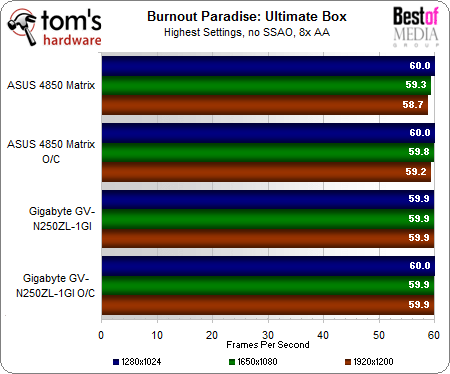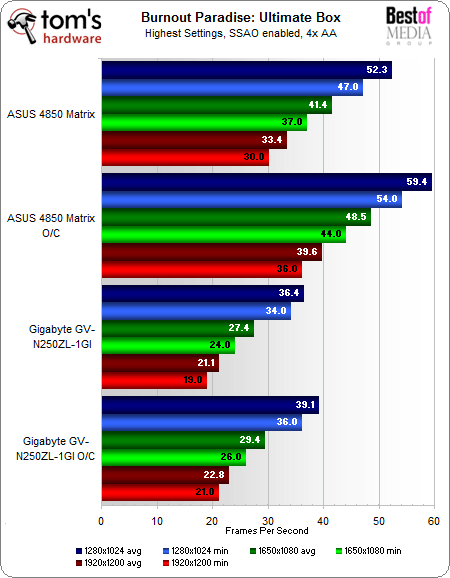Radeon HD 4850 Vs. GeForce GTS 250: Non-Reference Battle
Game Benchmarks: Burnout Paradise: The Ultimate Box
Let’s move on to this great racing game, and while it has only recently become available to PC users, it runs on an absolutely gorgeous graphics engine.
First, we’ll try the highest in-game settings, except we’ll disable screen space ambient occlusion (SSAO). We’ll even add 8xAA to the mix, because Burnout Paradise doesn’t seem to have an option to turn off vsync. The high level of anti-aliasing should make it a little more challenging for the frame rates to reach the Vsync limitation of 60 Hz:
Well, it looks like even 8xAA couldn’t pull the pack apart, with incredibly smooth frame rates limited only by vsync. We’re going to have to rely on the SSAO option to really tax these cards and show us a meaningful spread. SSAO isn’t a common option in PC games and has been pioneered by next-generation graphics engines like the one in Crysis. What it does is keep simulated ambient light from shining in places where it should be darker and in doing so adds a lot more realism to the lighting model. On the downside, it’s a very shader-intensive feature, so since we’re turning on SSAO, we’ll also lower the anti-aliasing to 4xAA to help the cards cope:
SSAO is definitely a differentiator between our two competitors. This visual enhancement feature in Burnout clearly has an affinity for the Radeon HD 4850 architecture, and perhaps this is linked to the Radeon’s DirectX 10.1 ability versus the GeForce GTS 250’s DirectX 10 specification. We’ll dig into this in a review later this month.
Unfortunately, it’s somewhat of a pyrrhic victory for the Radeon HD 4850 for two reasons: first, it slows the frame rates down so much that it’s not all that playable except at the lowest resolutions. Secondly, enabling the SSAO option seemed to cause some distracting blur artifacts on telephone and power lines in the game, regardless of the graphics card used. In any case, it provides some interesting food for thought, as SSAO will likely be used more commonly as time goes on.
Get Tom's Hardware's best news and in-depth reviews, straight to your inbox.
Current page: Game Benchmarks: Burnout Paradise: The Ultimate Box
Prev Page Game Benchmarks: World in Conflict Next Page Power, Temperature, And Noise BenchmarksDon Woligroski was a former senior hardware editor for Tom's Hardware. He has covered a wide range of PC hardware topics, including CPUs, GPUs, system building, and emerging technologies.
-
tuannguyen rags_20In the second picture of the 4850, the card can be seen bent due to the weight.Reply
Hi rags_20 -
Actually, the appearance of the card in that picture is caused by barrel or pincushion distortion of the lens used to take the photo. The card itself isn't bent.
/ Tuan -
jebusv20 demonhorde665... try not to triple post.Reply
looks bad... and eratic. and makes the forums/coments system
more clutered than need be.
ps. your not running the same bench markes as Toms so your not really comparable.
yes, same game and engine, but for example in crysis, the frame rates are completely different from the start, through to the snowey bit at the end.
pps. are you comparing your card to there card at the same resolution? -
alexcuria Hi,Reply
I've been looking for a comparison like this for several weeks. Thank you although it didn't help me too much in my decision. I also missed some comments regarding the Physix, Cuda, DirectX 10 or 10.1 and Havok discussion.
I would be very happy to read a review for the Gainward HD4850 Golden Sample "Goes Like Hell" with the faster GDDR5 memory. If it then CLEARLY takes the lead over the GTS 250 and gets even closer to the HD4870 then my decision will be easy. Less heat, less consumption and almost same performance than a stock 4870. Enough for me.
btw. Resolutions I'm most interested in: 1440x900 and 1650x1080 for 20" monitor.
Thank you -
spanner_razor Under the test setup section the cpu is listed as core 2 duo q6600, should it not be listed as a quad? Feel free to delete this comment if it is wrong or when you fix the erratum.Reply -
KyleSTL Why a Q6600/750i setup? That is certainly less than ideal. A Q9550/P45 or 920/X58 would have been a better choice in my opinion (and may have exhibited a greater difference between the cards).Reply -
B-Unit zipzoomflyhighand no the Q6600 is classified as a C2D. Its two E6600's crammed on one die.Reply
No, its classified as a C2Q. E6600 is classified as C2D. -
KyleSTL ZZFhigh,Reply
Directly from the article on page 11:
Game Benchmarks: Left 4 Dead
Clearly this is not an ideal setup to eliminate the processor from affecting benchmark results of the two cards. Most games are not multithreaded, so the 2.4Ghz clock of the Q6600 will undoubtedly hold back a lot of games since they will not be able to utilize all 4 cores.
Let’s move on to a game where we can crank up the eye candy, even at 1920x1200. At maximum detail, can we see any advantage to either card?
Nothing to see here, though given the results in our original GeForce GTS 250 review, this is likely a result of our Core 2 Quad processor holding back performance.
To all,
Stop triple posting!
-
weakerthans4 ReplyThe default clock speeds for the Gigabyte GV-N250ZL-1GI are 738 MHz on the GPU, 1,836 MHz on the shaders, and 2,200 MHz on the memory. Once again, these are exactly the same as the reference GeForce GTS 250 speeds.
Later in the article you write,or the sake of argument, let’s say most cards can make it to 800 MHz, which is a 62 MHz overclock. So, for Gigabyte’s claim of a 10% overclocking increase, we’ll say that most GV-N250ZL-1GI cards should be able to get to at least 806.2 MHz on the GPU. Hey, let’s round it up to 807 MHz to keep things clean. Did the GV-N250ZL-1GI beat the spread? It sure did. With absolutely no modifications except to raw clock speeds, our sample GV-N250ZL-1GI made it to 815 MHz rock-solid stable. That’s a 20% increase over an "expected" overclock according to our unscientific calculation.
Your math is wrong. A claim of 20% over clock on the GV-N250ZL-1GI would equal 885.6 MHz. 10% of 738MHz = 73.8 MHz. So a 10% overclock would equal 811.8 MHz. 815 MHz is nowhere near 20%. In fact, according to your numbers, the GV-N250ZL-1GI barely lives up to its 10% minimal capability.

